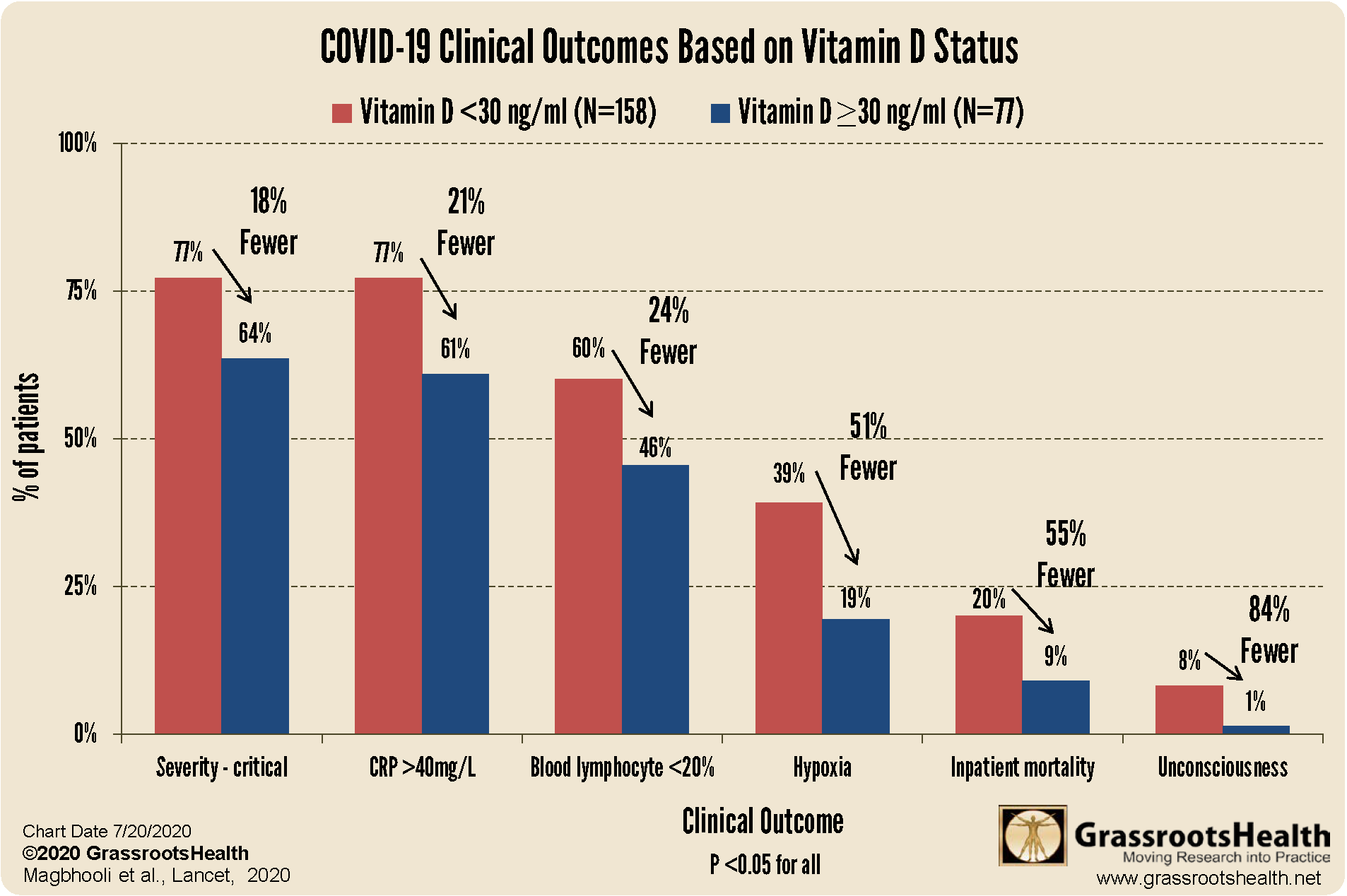Published on February 8, 2021
What is Vitamin D Good For? (Part 3: The Dermatological System) – Vitamin D is needed by virtually every cell in the body, and is essential for hundreds of processes each and every day
 Vitamin D contributes to hundreds of physiological processes each day having to do with a wide array of health effects, which is why a deficiency can lead to so many different negative health outcomes – from brittle bones to heart disease and cancer. Vitamin D acts as a protector and regulator so it is able to enhance the functioning of our cells, tissues and organs to keep us healthy and defend against diseases of many kinds. From musculoskeletal to cognitive and mental-emotional wellness, vitamin D has many benefits, and a deficit in vitamin D can lead to impairment or disease. With this in mind, why take a chance at being deficient in vitamin D?
Vitamin D contributes to hundreds of physiological processes each day having to do with a wide array of health effects, which is why a deficiency can lead to so many different negative health outcomes – from brittle bones to heart disease and cancer. Vitamin D acts as a protector and regulator so it is able to enhance the functioning of our cells, tissues and organs to keep us healthy and defend against diseases of many kinds. From musculoskeletal to cognitive and mental-emotional wellness, vitamin D has many benefits, and a deficit in vitamin D can lead to impairment or disease. With this in mind, why take a chance at being deficient in vitamin D?
Today, we take a look at why vitamin D is important to the health and function of the dermatological system – your skin not only makes vitamin D, but needs it to stay healthy!
Vitamin D Produced in the Skin also Helps Protect the Skin
Unlike traditional vitamins that you must get from your diet or supplements, vitamin D can be produced naturally in your skin when exposed to UVB rays in the proper circumstances.
Studies have shown that vitamin D made in the skin can decrease DNA damage in the skin cells, facilitate DNA repair acting directly upon any UV damage produced from sun exposure, and help prevent cell death. Furthermore, sensible exposure to sunlight actually protects the skin and deeper tissues from UV damage by increasing pigmentation (short term tanning) and thickening the outermost layer of skin – a process beneficial even for those with already darker skin. In fact, one study following 29,518 Swedish women over 20 years found that all-cause mortality was inversely related to sun exposure, in other words the risk of death was higher in those who avoided the sun.
Moreover, keratinocytes, which make up over 90% of the outermost layer of skin, cannot rely on vitamin D3 from supplements. Keratinocytes must synthesize their own supply of vitamin D directly from sun exposure, or by topical application as described in a review by Bolerazska et al. (2017) – so make sure you feed your keratinocytes vitamin D from the sun or topical application!
What Does Vitamin D do for the Skin?
Vitamin D roles in the dermatological system include:
- Vitamin D synthesis begins when the skin is exposed to the sun when it contains UVB rays (this varies depending on latitude and time of year)
- Important for normal hair, skin and nail growth
- Protects from excessive cell proliferation (e.g. skin cancer or psoriasis)
Dermatological Diseases associated with low vitamin D include:
- Psoriasis
- Skin Cancer
- Skin infections such as Staphylococcus aureus
- Raynaud’s syndrome
Vitamin D, Sun Exposure, and Skin Cancer
Melanoma accounts for approximately 1-7% of all skin cancers (depending on the country) and is most dangerous among skin cancers because it is more likely to spread to other parts of the body (metastasize) if not caught early. Despite public health messages to the contrary, not all skin cancers, particularly melanomas and basal cell carcinomas, are directly attributable to moderate sun exposure. Painful sunburns before the age of 20 seem to be a strong predictor of all types of skin cancer, and chronic or lifetime sun exposure has been associated with an increased risk of SCC but a decreased risk of BCC and melanoma.
In fact, the vitamin D made in the skin can help protect from melanoma. Research shows that people who have a vitamin D level of at least 30 ng/ml (75 nmol/L) have a 96% reduced risk of melanoma as evidenced by a case-control study by Cattaruzza et al. (2018):
Results from this study showed a clear decrease in melanoma risk as vitamin D levels increased, as illustrated in the chart above. The study included 137 melanoma patients and 99 healthy controls. The research team found that the average vitamin D level of melanoma patients was lower than the average level of the healthy controls by 10 ng/ml (25 nmol/L) and that the majority of melanoma patients had vitamin D levels at or below 20 ng/ml (50 nmol/L) compared to just 15% of the healthy controls. Furthermore, participants with vitamin D levels at or above 30 ng/ml (75 nmol/L) had a 96% lower risk of melanoma compared to participants with levels at or below 20 ng/ml (50 nmol/L) after adjusting for age, sex and BMI.
Other Important Co-Nutrients for Dermatological Health
Don’t forget that vitamin D works along with other essential nutrients for our health. For our skin, hair and nails, these include:
- Omega-3s for skin cancer
- Vitamin C plays an important role in collagen production and acts as an antioxidant to protect against sun damage
- Vitamin E, like vitamin C, functions as an antioxidant in the skin to protect against sun damage
- B Vitamins
- Zinc and Copper
Are You Getting Enough Vitamin D to Support Healthy Skin, Hair and Nails?
With almost 90% of the general population having vitamin D levels below the recommended 40-60 ng/ml (100-150 nmol/L), it is obvious that most people need more vitamin D. While most of us cannot achieve a vitamin D level of 40-60 ng/ml from sun alone, either due to our lifestyle, where we live, or other circumstances, we can certainly reach those levels with the right amount of supplementation.
Below is a guide for how much you might need, and who may need more. Your levels can be tested safely at home – order your home test kit today.
By joining the GrassrootsHealth projects, you are not only contributing valuable information to our study, but you are also gaining knowledge about how you could improve your own health through measuring and tracking your nutrient status, and educating yourself on how to improve it. Do you know what your status of vitamin D, omega-3s, and other essential nutrients is? Could your levels be improved? Test now to find out!
 We now have a NEW GIFTING SERVICE that allows you to quickly send ‘Gift Cards’ to friends, family and coworkers who you consider might need immediate access to testing, and to Claim the Joy of Your Health TODAY. Give the gift today!
We now have a NEW GIFTING SERVICE that allows you to quickly send ‘Gift Cards’ to friends, family and coworkers who you consider might need immediate access to testing, and to Claim the Joy of Your Health TODAY. Give the gift today!
What does the Research Say about Vitamin D & COVID-19?
It’s TIME to start saving lives! If you can help PREVENT the majority of the death, it’s time! What’s it costing you/us not to take action NOW?
There is much published research that supports a clear link between vitamin D and COVID-19 showing that higher vitamin D levels are related to:
a decreased risk of testing positive for COVID-19
 increased viral SARS-CoV-2 RNA clearance
increased viral SARS-CoV-2 RNA clearance
better clinical outcomes among patients with COVID-19
decreased risk of death due to COVID-19
Be sure to educate yourself on the benefits and importance of vitamin D for immune health, and take steps to ensure you and your loved ones are getting enough.
You can review all of the COVID-19 and immune health information we have shared on this page.












